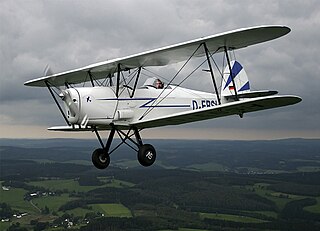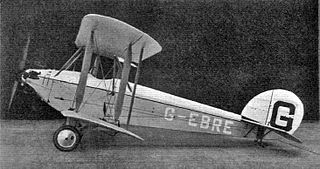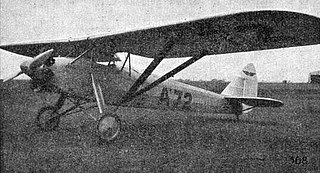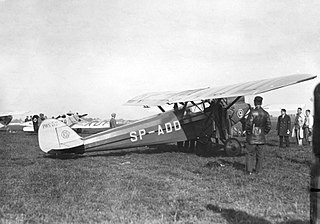
The Ikarus Aero 2 was a piston-engined military trainer aircraft built in Yugoslavia in the years following World War II, although the design pre-dated the war.

The Aero A.32 was a biplane built in Czechoslovakia in the late 1920s for army co-operation duties including reconnaissance and tactical bombing. While the design took the Aero A.11 as its starting point, the aircraft incorporated significant changes to make it suited for its new low-level role.

The Aero A.38 was a Czechoslovakian biplane airliner of the 1920s and 1930s. Following the relatively modern A.35, this aircraft was something of a throwback, marrying a fuselage derived from the A.35 to wings copied from the A.23. A few served with CSA, and others with French airline Compagnie Internationale de Navigation Aérienne. These latter aircraft were powered by a French Gnome-Rhône engine instead.

The Stampe et Vertongen SV.4 is a Belgian two-seat trainer/tourer biplane designed and built by Stampe et Vertongen. The aircraft was also built under licence in France and French Algeria.

The PZL-5 was a Polish two-seat touring and sports aircraft of 1930 constructed and produced by the PZL.

The Avro Club Cadet was a 1930s single-engined British biplane trainer aircraft, designed and built by Avro as a development of the earlier Cadet. It was planned for private and club use and, unlike the Cadet, was fitted with folding wings.

The Bartel BM.4 was a Polish biplane primary trainer aircraft used from 1929 to 1939 by the Polish Air Force and Polish civilian aviation, manufactured in the Samolot factory in Poznań. It was the first plane of Polish design put into production.

The Blackburn L.1 Bluebird was a British single-engine biplane light trainer/tourer with side-by-side seating, built in small numbers by Blackburn Aircraft in the 1920s.

The Bristol Boarhound was a British army cooperation and liaison aircraft of the 1920s. It was a two-seat biplane with wings of equal span and a steel frame construction with fabric covering.

The Caudron C.280 Phalène ("Moth") was a civil utility aircraft built in France during the 1930s. It was a high-wing braced monoplane of conventional configuration with fixed tailskid undercarriage. The pilot and two-three passengers were accommodated within an enclosed cabin. The structure was wooden throughout, with the forward fuselage skinned with plywood, and the rest of the aircraft fabric-covered.

The Farman F.430 was a 1930s French light transport designed and built by the Farman Aviation Works. Two variants with different engines were known as the F.431 and F.432.

The P.W.S.8 was a 1930 Polish sports plane, constructed by the Podlaska Wytwórnia Samolotów (PWS), that remained a prototype.

The Hopfner HS-8/29 was a utility aircraft built in Austria in the late 1920s based on the Hopfner HS-5/28. It used a modernised version of its predecessor's airframe, being a conventional, parasol-wing monoplane with seating for two occupants in tandem, open cockpits. The landing gear was of fixed, tailskid type with divided main units. The first prototype used the same Walter NZ 85 engine that the later HS-5/28s had used, but this was followed by 14 production examples with Siemens engines, and a single prototype with a de Havilland Gipsy III.

The Westland Widgeon was a British light aircraft of the 1920s. A single-engined parasol monoplane, the Widgeon was built in small numbers before Westland abandoned production in 1929.

The PWS-52 was a Polish sports aircraft of 1930, a single-engine high-wing monoplane, constructed by the Podlaska Wytwórnia Samolotów (PWS), that remained a prototype.

The CASA III was a 1920s Spanish two-seat monoplane, designed by Luis Sousa Peco and built by Construcciones Aeronáuticas SA (CASA) at Getafe near Madrid.

The Hispano-Suiza E-34, later renamed Hispano HS-34, was a Spanish single engine, tandem seat biplane, designed as a basic trainer. Twenty five were ordered by the Aeronáutica Naval, but only five had been completed when the Spanish Civil War intervened.

The Pander E was the first indigenous Dutch training aircraft, used by clubs and also privately owned. A two-seat, single-engine biplane, 17 were built in the Netherlands from 1926 with engines of increasing power.
The Redfern DH-2 is an American homebuilt aircraft that was designed by Walter Redfern and produced by the Walter Redfern Company of Post Falls, Idaho, based upon the 1915 Airco DH.2 fighter aircraft. When it was available the aircraft was supplied in the form of plans for amateur construction.

The Gee Bee Model A was an American two-seat open cockpit single-bay biplane developed by the Granville Brothers that first flew in 1929.




















